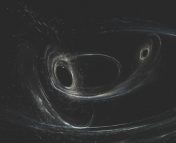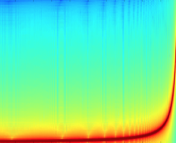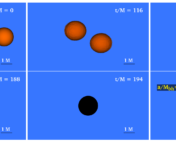This guest post was written by Andreas Christ Sølvsten Jørgensen, a postdoctoral research fellow at the University of Birmingham. Previous to his position in Birmingham, Andreas earned his PhD at the Max Planck Institute for Astrophysics in 2019. He works within the field of theoretical stellar physics, primarily focusing on hydrodynamic phenomena, such as convective processes in the outermost layers of low-mass stars. He thus develops upon stellar structure and evolution models and compares model predictions with observational data.
Title: Constraints from gravitational wave detections of binary black hole mergers on the 12C(α, γ)16O rate
Authors: Robert Farmer, Mathieu Renzo, Selma E. de Mink, Maya Fishbach, and Stephen Justham
First Author’s Institution: Anton Pannekoek Institute for Astronomy and University of Amsterdam
Status: Open access on ArXiv
How would you go about determining the properties of carbon in fusion reactions? While the answers to such questions can be detrimental to our understanding of stellar evolution, tight constraints on nuclear reaction rates can often be hard to come by. Indeed, it might not be feasible to measure the relevant cross-sections under laboratory conditions. This is, for instance, the case for the reaction that underlies the formation of oxygen through the fusion of carbon with helium. The fact that we do not have tight constraints on some nuclear reaction rates translates directly into ambiguities in predictions of numerical stellar models, posing a problem for theoretical astrophysicists.
Today’s authors present a creative approach to address this issue by investigating the remnants of massive stars: they search for answers by looking at stellar black holes. More specifically, they turn the problem on its head. Rather than using existing constraints on nuclear reaction rates to infer constraints on stellar evolution, they demonstrate how our knowledge on the final fate of stars can shed light on nuclear reaction rates. To do so, today’s authors draw on both detailed stellar evolution calculations and gravitational wave measurements.
Disappeared without a trace
To better understand the approach of today’s authors, we first have to dive into the life cycle of massive stars. After the production of helium through hydrogen burning, helium burning will eventually set in at the stellar centre. During helium burning, carbon is produced and might be converted into oxygen through the capture of additional helium nuclei. How effectively this conversion takes place will determine the ratio of carbon to oxygen when the central helium deposit has been depleted. At this point in its evolution, with helium being exhausted, the star has to resort to other means of energy production. Depending on the available carbon deposit and thus on the carbon-to-oxygen ratio, central carbon burning and carbon shell burning will either be possible or severely suppressed. Needless to say that this will affect the interior stellar structure and its evolution, but what does this have to do with black holes?
To answer this question, we first have to understand the formation of stellar black holes. Stellar black holes are formed when the cores of massive stars collapse under their own gravity, having exhausted their means of energy production by fusion reactions. However, this is not the whole story. Under certain circumstances, very massive stars are prone to so-called pair-instabilities. In such cases, fluctuations in the production of electron-positron pairs from gamma-rays may lead to a dynamical collapse. Unless photodisintegration sets in before oxygen ignition, the core will bounce back, as the dynamical collapse is halted by the onset of explosive oxygen burning. If the star bounces back, this process might either lead to severe mass loss or completely disrupt the star, leaving no remnant behind. We refer to the latter scenario as a pair-instability supernova (PISN). As a result, very massive stars within a certain mass range do not leave black holes behind. This leads to a gap in the mass distribution of stellar black holes. The crux is that the occurrence of pair-instabilities in massive stars depend on the detailed structure of the star and is highly sensitive to the carbon-to-oxygen ratio. As shown by today’s authors, this implies that the position of the gap in the black-hole mass distribution is sensitive to the rate at which carbon is converted into oxygen during helium burning. It follows that observational constraints on the black-hole mass gap, therefore, allow us to draw conclusions on this nuclear reaction. Today’s authors did just that.
From black holes to atomic nuclei
In the last few years, constraints on black-hole masses have become available through the detection of black-hole mergers in gravitational wave experiments. Indeed, in 2017, the Nobel Prize in physics was awarded for the detection of gravitational waves from such a black-hole merger. Based on ten such measurements, today’s authors present a lower limit on the so-called astrophysical S-factor for the conversion of carbon into oxygen. The S-factor expresses the cross-section of the reaction at a given energy. In addition, the authors show that they will be able to infer tight constraints on the S-factor, once the number of gravitational wave detections has increased fivefold. This is a truly mind-blowing result. Think about it: based on a faint signal from distant merging black holes, the authors are able to reconstruct the evolution that led to the formation of these black holes with such detail that they can draw conclusions about the properties of atomic nuclei.
Of course, there are other model uncertainties, including physical uncertainties and numerics, that might skew the results, and further improvements of the stellar models are necessary to fully exploit the data. For instance, the conversion of carbon into oxygen is not the only ill-constrained reaction that enters stellar evolution calculations. However, in this paper, as well as two companion papers, today’s authors demonstrate that many of these other model uncertainties are secondary to the influence of the carbon-to-oxygen ratio. Although the effect of some assumptions have either not been quantified or fully explored, and although other model properties might play a role for the position of the mass gap, the authors are thus able to make a strong case for the asserted lower limit on the S-factor.Finally, based on their results, the authors present another independent lower limit on the S– factor. This limit will come into play if an unambiguous detection of a so-called pulsating PISN is made. A pulsating PISN suffers from mass loss due to pair-instabilities but is not completely disrupted as a result of explosive oxygen burning. Today’s authors show that such stars only exist if carbon is sufficiently efficiently converted into oxygen during helium burning. Upcoming surveys, such as LSST, might detect pulsating PISN and thereby be able to settle this issue. Thus, future observational constraints promise even deeper insights. Let’s, therefore, end on the same positive note as the authors, pointing to the vast realm of possibilities that future gravitational wave detections offer.




